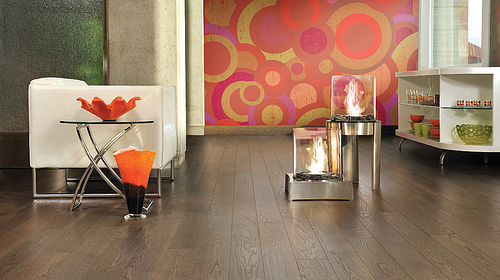Hardwood Floor vs Engineered Floor
On the surface, a traditional solid hardwood floor and an engineered wood floor are pretty much identical. They look the same. They can be made with the same wood species. They're offered with the same specialty textures and finish options. And both are real hardwood -- remember, we're still talking about the surface. It's when you look a little deeper that you see the differences come into view, and that's where the debate over a hardwood floor versus engineered floor begins.
Construction
Solid strips and planks have been the standard for hardwood flooring for well over a century. The most common type is 3/4 inch thick and about 2-1/4 inches wide, but different thicknesses and (especially) different widths are commonly available. Most types have tongue-and-groove (T&G) edges, which help keep the boards flat and allow for hiding the fasteners holding the boards to the subflooring. Solid hardwood is just that -- a single piece of solid wood from top to bottom.
Engineered hardwood flooring is constructed just like plywood and has three or more thin layers of relatively low-grade wood topped with a solid-hardwood top layer. This allows for efficient use of wood resources, but the greater advantage is the cross-grain construction: as with plywood, the layers of engineered flooring are arranged so that the grain of each layer runs perpendicular to that of the layers above and below. Wood expands and contracts mostly along its width (across the grain), and cross-graining helps to keep this movement in check. Thus, engineered flooring is less susceptible to expansion and contraction than solid hardwood flooring.
Installation and Finishing
A solid hardwood floor typically is nailed to a wood subfloor but can be glued down in some applications. Engineered flooring can be stapled to wood or glued to concrete. Some engineered products can be installed as floating floors, in which the individual pieces are snapped or fitted together and the entire floor assembly rests on the subfloor without being fastened (similar to the standard installation of laminate flooring).
Solid hardwood is sold in both unfinished and prefinished versions. Unfinished boards are installed and then sanded smooth and finished on-site. Prefinished flooring is ready to walk on once it's installed. Almost all engineered flooring is prefinished. While on-site finishing is messy, smelly and time-consuming, it offers one potentially significant advantage: because the flooring gets sanded after it's installed, any height variation between boards is eliminated, creating an exceptionally smooth surface. With prefinished flooring, height variations, though typically slight (with a good installer), aren't correctable. Some prefinished flooring is milled with slightly beveled edges to prevent noticeable ridges between boards, and this imparts a subtle but distinctive look to the floor; be sure to see samples of installed flooring before choosing. If you need help choosing and installing your flooring, be sure to contact professional flooring contractors to get your project done.
Location
Thanks to its layered, cross-grain construction, engineered flooring can go places where solid hardwood can't -- namely, in basements and other rooms that are below ground. You can probably guess the reasoning here: moisture. Basement floors emit more moisture than aboveground floors (including first-floor concrete slabs, or slabs-on-grade).
Another application that raises the question of hardwood floor versus engineered floor is when installing the flooring over radiant heating (typically hot-water tubing snaking underneath the finished floor). Again, changes in moisture can create excessive movement in solid wood, leading to gaps and possibly small cracks ("checking") during the heating season. It's possible to lay solid hardwood over radiant tubing, but some species perform better than others in this case. Quarter-sawn planks on the narrow side of the spectrum (say, 2-1/4 inches or narrower) tend to move less than wider, plain-sawn planks. Species is another factor: oak, American cherry, and some other wood types react less to moisture changes than maple, for example. In any case, engineered flooring is a safer choice over radiant heating, and wood species is not a concern.
Refinishing
Here's where solid hardwood has always been the winner in the hardwood floor versus engineered floor debate. A 3/4-inch-thick hardwood floorboard typically has a good 1/4 inch of solid wood, measuring down from its top surface to the tongue. This means the boards can be sanded and refinished several times over the lifetime of the flooring. By contrast, the sandable portion of engineered flooring is only about 5/32-inch or thinner, so most floors can be sanded only once or twice. Solid hardwood that is sanded and finished on site often can be screened (scuff-sanded) and recoated, while prefinished flooring cannot.
That said, these differences aren't a deal-breaker for many homeowners, for two reasons. First, if you're installing new flooring you're going to take very good care of it, and refinishing may be 15 or more years down the road, if ever. (A lot of sanding and refinishing takes place when buyers of an existing home want to reclaim wood floors that have been neglected by previous owners or hidden under pistachio-green carpet since the Carter administration.) Second, using prefinished flooring means you don't have the initial sanding of a traditional site-finished floor; so that's one sanding you can avoid (with either type of flooring). And the factory finishes on prefinished products are tough -- warrantees of 15 to 25 years are not uncommon -- making refinishing a less likely proposition overall.
Cost
The price factor of a hardwood floor versus engineered floor typically isn't much of a factor at all. On average, solid hardwood is slightly more expensive than engineered, but both types cover wide ranges of price and quality. In the middle of those ranges, the cost differences aren't significant.
Philip Schmidt writes for Networx.com.
Looking for a Pro? Call us (866) 441-6648

Flooring Average Costs
Flooring Contractors Experiences

A Local Pro To Install My Bathroom Floor Tile Was The Best Choice

Newly Tiled Floor For A Rental Property




